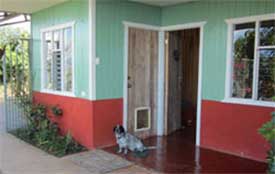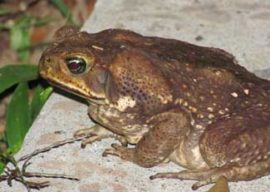Thud-up
 I heard it and woke from a sound sleep. In the dim light I looked to Seurat, my sweet Blue Healer/Bassett hound-friend lying on the sheet at the foot of my bed, his head resting on my ankles. With eyes open, he looked attentive but unconcerned. I knew he recognized the sound. Emphasizing his nonchalance, he repositioned himself with his back to my legs and dropped back into slumber with an audible exhale. I didn’t. This was the third time this night! Rather than wait longer, I got up to find the familiar flashlight, towel and broom. Peering under the bed I located the culprit in the far corner. The good sized cane toad had made his way into my room where his nocturnal hopping had finally hit the underside of my bed – thud-up. Using the broom I herded him out into the room where I tossed a towel over him, calming him enough so I could pick him up in the towel and carry him outside to freedom. Back in bed I thought about the three toads in one night – and as I drifted off to sleep again my mind played with the similarities between a Three Toad Night and a Three Dog Night….
I heard it and woke from a sound sleep. In the dim light I looked to Seurat, my sweet Blue Healer/Bassett hound-friend lying on the sheet at the foot of my bed, his head resting on my ankles. With eyes open, he looked attentive but unconcerned. I knew he recognized the sound. Emphasizing his nonchalance, he repositioned himself with his back to my legs and dropped back into slumber with an audible exhale. I didn’t. This was the third time this night! Rather than wait longer, I got up to find the familiar flashlight, towel and broom. Peering under the bed I located the culprit in the far corner. The good sized cane toad had made his way into my room where his nocturnal hopping had finally hit the underside of my bed – thud-up. Using the broom I herded him out into the room where I tossed a towel over him, calming him enough so I could pick him up in the towel and carry him outside to freedom. Back in bed I thought about the three toads in one night – and as I drifted off to sleep again my mind played with the similarities between a Three Toad Night and a Three Dog Night….
A Three Dog Night is not just the name of a rock band. It is an idiom that refers to being cold. Cowboys out on the range slept with their dogs to keep warm. A one dog night was cold enough to need one dog and a three dog night was an extremely cold night needing body heat of three dogs. You could ask someone, “how cold was it?” and they could reply that “it was a three dog night” and the explanation was crystal clear.
The same may be true for a Three Toad Night. The idiom could be for a night of interrupted sleep. ‘It was a three toad night” – meaning, I was awakened several times.
While interrupted sleep can and does happen everywhere, I suspect that cane toad wakings may be a more common experience that many admit to. Here where I live there is often very little buffer between indoors and outdoors, especially in the rural areas. Our doors and windows are often open invitations to nature’s perusal.
Our gentle climate varies little in temperature throughout the year. Inland and well below the tallest mountain tops, our highs may range from 75 to 85 degrees F. And our lows seldom drop below the 62 degree mark. Requiring no air conditioning or heating, our homes are the same temperature inside as the air outside. So, we often leave our doors wide open as we walk into and out of our temperate air. Our seasonal variations are mostly in terms of rainfall. We have a dry season with little rainfall that normally extends from Dec through early April here in the southern zone. The rains return in mid April in the form of afternoon and/or evening rain showers – usually with sunny mornings. Our days are about 12 hours long and so are our nights.
 The women of Costa Rica greet the morning sun with their custom of sweeping dirt or dust out through the front door. The door is opened then and will likely remain open all day – as people come and go, friends and neighbors stop by, children come and go from school and as a ready signal that they are home. In the early evening around 5 p.m. – just before the sun goes down, there may be a rain shower while folks are inside preparing and eating dinner. And this is when the nocturnal cane toads appear. The still open door is an obvious invitation and offers easy access.
The women of Costa Rica greet the morning sun with their custom of sweeping dirt or dust out through the front door. The door is opened then and will likely remain open all day – as people come and go, friends and neighbors stop by, children come and go from school and as a ready signal that they are home. In the early evening around 5 p.m. – just before the sun goes down, there may be a rain shower while folks are inside preparing and eating dinner. And this is when the nocturnal cane toads appear. The still open door is an obvious invitation and offers easy access.
Our cane toads (Bufo marinus) are indigenous to southern and central America and are truly giants – the largest amphibians we have! Some females reach a size of nearly 4 lbs! The toads were actually introduced to Australia from Hawaii in the 1930’s to deal with the sugar cane grubs and did such a terrific job that they are now considered pests themselves. Here in Costa Rica they are a more welcome ‘pest’ because they eat insects and even small mammals such as mice and rats. They’ll even eat dog food!
Gentle and usally slow moving, they are welcome in my garden, as are all animals. And they are smarter than we humans believe. I’ve seen a cane toad watch to see if I was coming and then hop to a sheltered cover to out of the way! Though poisonous, with poison glands located just behind the eye, these are gentle creatures. Their toxic venom can be hallucinogenic and is of some interest to indigenous peoples in Central and South America. There are even reputable reports that some dogs have learned to lick toads for a psychedelic high. I’m wondering now about Seurat.
Sometimes I catch him watching a toad and then he appears to glance over at me – to see if I’m watching?
 I have not yet experienced a 4 toad night and don’t intend to. At around 4 I close my front door and so far the toads have not figured out the adjacent dog door. But every once in awhile I find a toad inside and wonder. And when I hear the familiar ‘thudup’ sound that wakes me, I look first to Seurat. If he is calm and awake I know. There is a toad under the bed.
I have not yet experienced a 4 toad night and don’t intend to. At around 4 I close my front door and so far the toads have not figured out the adjacent dog door. But every once in awhile I find a toad inside and wonder. And when I hear the familiar ‘thudup’ sound that wakes me, I look first to Seurat. If he is calm and awake I know. There is a toad under the bed.
Thud-up.


